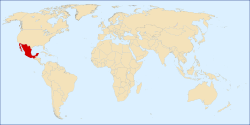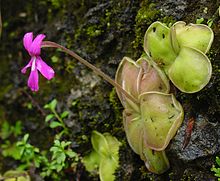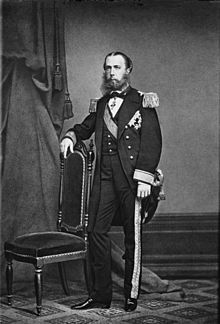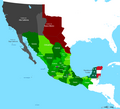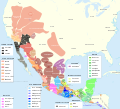|
The Temple of Warriors at Chichen Itza, Mexico
¡Bienvenido! Welcome to the Mexico portal
Mexico, officially the United Mexican States, is a country in the southern portion of North America. It covers 1,972,550 km2 (761,610 sq mi), making it the world's 13th-largest country by area; with a population of almost 130 million, it is the 10th-most-populous country and the most populous Spanish-speaking country. Mexico is organized as a federal constitutional republic comprising 31 states and Mexico City, its capital and largest city. It shares land borders with the United States to the north, with Guatemala and Belize to the southeast; as well as maritime borders with the Pacific Ocean to the west, the Caribbean Sea to the southeast, and the Gulf of Mexico to the east.
This is a Featured article, which represents some of the best content on English Wikipedia.
Pinguicula moranensis /pɪŋˈɡwɪkjʊlə ˌmɒrəˈnɛnsɪs/ is a perennial rosette-forming insectivorous herb in the flowering plant family Lentibulariaceae. It is native to El Salvador, Guatemala, Honduras and Mexico. A species of butterwort, it forms summer rosettes of flat, succulent leaves up to 10 centimeters (4 in) long, which are covered in mucilaginous (sticky) glands that attract, trap, and digest arthropod prey. Nutrients derived from the prey are used to supplement the nutrient-poor substrate that the plant grows in. In the winter the plant forms a non-carnivorous rosette of small, fleshy leaves that conserves energy while food and moisture supplies are low. Single pink, purple, or violet flowers appear twice a year on upright stalks up to 25 centimeters long. The species was first collected by Humboldt and Bonpland on the outskirts of Mina de Morán in the Sierra de Pachuca of the modern-day Mexican state of Hidalgo on their Latin American expedition of 1799–1804. Based on these collections, Carl Sigismund Kunth described this species in Nova Genera et Species Plantarum in 1817. The extremely variable species has been redefined at least twice since, while several new species have been segregated from it based on various geographical or morphological distinctions, although the legitimacy of some of these is still debated. P. moranensis remains the most common and most widely distributed member of the Section Orcheosanthus. It has long been cultivated for its carnivorous nature and attractive flowers, and is one of the most common butterworts in cultivation. (Full article...)Selected article -Guadalajara (/ˌɡwɑːdələˈhɑːrə/ GWAH-də-lə-HAR-ə, Spanish: [ɡwaðalaˈxaɾa] ) is a city in western Mexico and the capital of the state of Jalisco. According to the 2020 census, the city has a population of 1,385,629 people, making it the 7th most populous city in Mexico, while the Guadalajara metropolitan area has a population of 5,268,642 people, making it the third-largest metropolitan area in the country and the twentieth largest metropolitan area in the Americas. Guadalajara has the second-highest population density in Mexico, with over 10,361 people per square kilometer. Within Mexico, Guadalajara is a center of business, arts and culture, technology and tourism; as well as the economic center of the Bajío region. It usually ranks among the 100 most productive and globally competitive cities in the world. It is home to numerous landmarks, including Guadalajara Cathedral, the Teatro Degollado, the Templo Expiatorio, the UNESCO World Heritage site Hospicio Cabañas, and the San Juan de Dios Market—the largest indoor market in Latin America. A settlement was established in the region of Guadalajara in early 1532 by Cristóbal de Oñate, a Basque conquistador in the expedition of Nuño Beltrán de Guzmán. The settlement was renamed and moved several times before assuming the name Guadalajara after the birthplace of Guzmán and ending up at its current location in the Atemajac Valley in 1542. On November 8, 1539, the Holy Roman Emperor Charles V had granted a coat of arms and the title of city to the new town and established it as the capital of the Kingdom of Nueva Galicia, part of the Viceroyalty of New Spain. After 1572, the Royal Audiencia of Guadalajara, previously subordinate to Mexico City, became the only authority in New Spain with autonomy over Nueva Galicia, owing to rapidly growing wealth in the kingdom following the discovery of silver. By the 18th century, Guadalajara had taken its place as Mexico's second largest city, following mass colonial migrations in the 1720s and 1760s. During the Mexican War of Independence, independence leader Miguel Hidalgo y Costilla established Mexico's first revolutionary government in Guadalajara in 1810. The city flourished during the Porfiriato (1876–1911), with the advent of the industrial revolution, but its growth was hampered significantly during the Mexican Revolution (1910–1920). In 1929, the Cristero War ended within the confines of the city, when President Plutarco Elías Calles proclaimed the Grito de Guadalajara. The city saw continuous growth throughout the rest of the 20th century, attaining a metro population of 1 million in the 1960s and surpassing 3 million in the 1990s. (Full article...)Selected picture Lithograph of the port of Acapulco in 1628, during the Viceroyalty of New Spain image credit: public domain
This is a Good article, an article that meets a core set of high editorial standards.
The Metropolitan Cathedral of the Assumption of the Most Blessed Virgin Mary into Heaven (Spanish: Catedral Metropolitana de la Asunción de la Bienaventurada Virgen María a los cielos) is the cathedral church of the Roman Catholic Archdiocese of Mexico. It is situated on top of the former Aztec sacred precinct near the Templo Mayor on the northern side of the Plaza de la Constitución (Zócalo) in the historic center of Mexico City. The cathedral was built in sections from 1573 to 1813 around the original church that was constructed soon after the Spanish conquest of Tenochtitlan, eventually replacing it entirely. Spanish architect Claudio de Arciniega planned the construction, drawing inspiration from Gothic cathedrals in Spain. Due to the long time it took to build it, just under 250 years, virtually all the main architects, painters, sculptors, gilding masters and other plastic artists of the viceroyalty worked at some point in the construction of the enclosure. The long construction time also led to the integration of a number of architectural styles in its design, including the Gothic, Baroque, Churrigueresque, Neoclassical styles, as they came into vogue over the centuries. It furthermore allowed the cathedral to include different ornaments, paintings, sculptures and furniture in its interior. The project was a point of social cohesion, because it involved so many generations and social classes, including ecclesiastical authorities, government authorities, and different religious orders. (Full article...)Selected biography -Maximilian I (German: Ferdinand Maximilian Josef Maria von Habsburg-Lothringen, Spanish: Fernando Maximiliano José María de Habsburgo-Lorena; 6 July 1832 – 19 June 1867) was an Austrian archduke who became emperor of the Second Mexican Empire from 10 April 1864 until his execution by the Mexican Republic on 19 June 1867. A member of the House of Habsburg-Lorraine, Maximilian was the younger brother of Emperor Franz Joseph I of Austria. Prior to his becoming Emperor of Mexico, he was commander-in-chief of the small Imperial Austrian Navy and briefly the Austrian viceroy of Lombardy–Venetia, but was removed by the emperor. Two years before his dismissal, he briefly met with French emperor Napoleon III in Paris, where he was approached by conservative Mexican monarchists seeking a European royal to rule Mexico. Initially Maximilian was not interested, but following his dismissal as viceroy, the Mexican monarchists' plan was far more appealing to him. (Full article...)
In the news
Selected fare or cuisine -
General imagesThe following are images from various Mexico-related articles on Wikipedia.
CategoriesTopicsRelated portalsWikiProjectYou are invited to participate in WikiProject Mexico, a WikiProject dedicated to developing and improving articles about Mexico. Associated WikimediaMore portals | ||||||||||||



